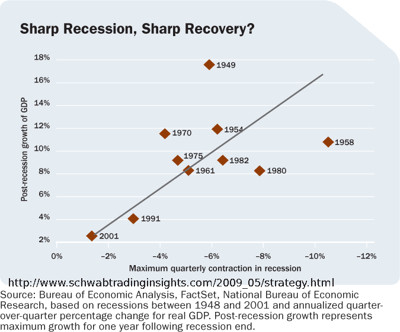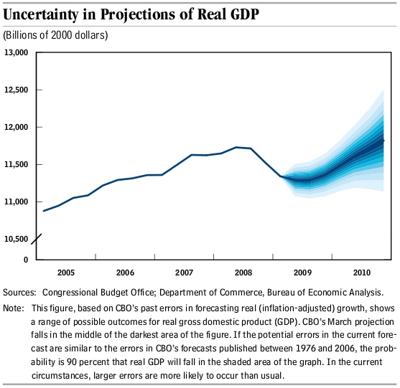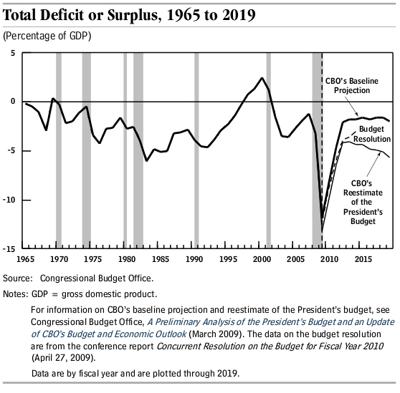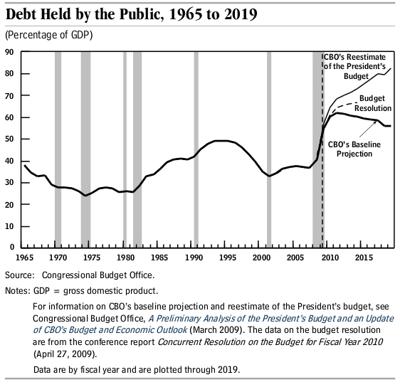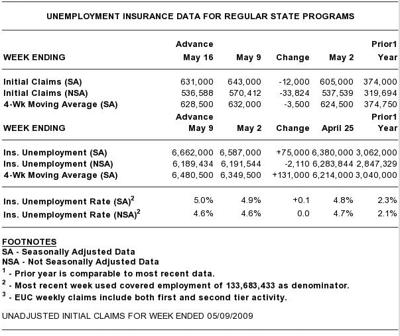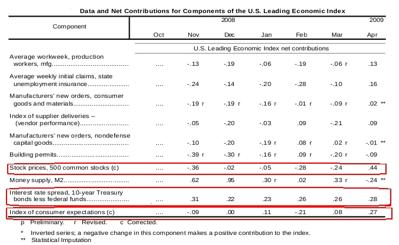子夜讀書心筆
寫日記的另一層妙用,就是一天辛苦下來,夜深人靜,借境調心,景與心會。有了這種時時靜悟的簡靜心態, 才有了對生活的敬重。"Predicting the economy is even more difficult than forecasting the weather, because an economy is not made up of molecules whose behavior is subject to the laws of physics, but rather of human beings who are themselves thinking about the future and whose behavior may be influenced by the forecasts that they or others make." (Fed Chairman Ben S. Bernanke at the 2009 Commencement of the Boston College School of Law, Newton, Massachusetts May 22, 2009)
We are continually trying to see the economic future. If we know what will happen, we can make adjustments to optimize our lives and our wealth. But alas, our economic future is not written – and the timing and the effects of what will happen are guesses.
Economists say that severe recessions are accompanied by robust recoveries. The following graph courtesy of Charles Schwab shows economic recovery following recessions. The claim is that 80% of the maximum quarterly fall in GDP is returned within the next year. In the case of our current recession, some punters are counting on a 6.3% annualized quarterly GDP fall blooming into a 5% GDP recovery in 2010.
The Congressional Budget Office (CBO) this week dipped their oar into the strength of the recovery discussion:
Many factors will temper the strength of the recovery: the loss of household wealth; the fragility of financial institutions; persistently weak growth in the rest of the world; a surplus of housing units on the market; and low utilization of manufacturing capacity. How much those factors will dampen the recovery is uncertain: They may be overcome relatively quickly by the jump start provided by the stimulus and improvements in consumer and business confidence, or they may cause the economy to slump again next year, as the effects of the stimulus begin to wane.
The CBO believes uncertainty is especially great around economic turning points and in conditions that have not been seen in the economy for some time, such as the current financial crisis. So their guesses of economic growth through 2010 have a range of over $1 trillion.
The CBO is actually exposing their errors in their past economic guesses. But the red flag the CBO raised was on government spending to mitigate the recession. They warned that
Budget deficits tend to slow economic growth in the long term if they are allowed to persist, because they tend to reduce capital accumulation and the upward trend in the economy’s capacity to produce.
The following graph illustrates what the current budget will do to the deficit.
My big concern is the governments debt servicing needs overpowering the private sectors ability to raise money. The following CBO graph illustrates this point.
The CBO issued a warning,
In addition to their negative long-term effects, [government] policies that substantially worsen the fiscal outlook can have negative short-term effects as well. The nation currently benefits greatly from the fact that investors worldwide consider U.S. Treasury securities a safe haven in times of trouble. That tendency provides an important advantage for the United States in times of crisis, helping to increase liquidity and decrease interest rates. If investors lost confidence in the government’s debt as a safe haven because of deterioration in the long-term fiscal outlook, the U.S. economy would lose that advantage, perhaps permanently.
This is not a warning by Dr. Doom, but by a government economic arm. Long term recovery is dependent on government fiscal responsibility. We all know this.
How many will bet Congress is capable of fiscal responsibility?
Additional Economic Events from this Past Week
The Philly Fed's April 2009 subjective Business Outlook Survey indicated the region’s manufacturing sector continued to decline this month, but some indexes suggest that the declines are diminishing. However, indicators for general activity, new orders, shipments, and employment all remained negative. Even more strongly indicative of continued weakness were the indexes for prices, which reached record lows. The reason this index rose is due to the expectation things will get better within the next 6 months.
I have significant concern over the Federal Debt – not only the massive size – but primarily because it will soon start crowding out corporate and and local government bonds. David W. Wilcox, Deputy Director, Division of Research and Statistics appearing before Congress this week said there was $2.7 trillion of municipal debt, and provided some comments:
grants to municipalities or the creation of new federal insurance or reinsurance programs should be implemented by Congress to address the current problems in the markets for municipal bond insurance.
The Federal Reserve Act imposes limits on the ability of the Federal Reserve to purchase municipal debt, including a six-month maturity limit so there is little the Fed can do.
The increase in government debt financing later this year corresponds to the timing of the great recovery the pundits are expecting. I am unable to see how this will end well.
The Housing Market Index (HMI), a subjective sentiment survey produced by National Association of Home Builders, rose slightly in May 2009. As in all subjective surveys, there are logic disconnects. In this case the number of perspective buyers remains flat, but sales are up.
The four week moving average of mortgage loan application volume decreased 6.4% and increased 42% compared with the same week one year earlier mostly caused by a decline in refinanced mortgages. The refinance share of mortgage activity increased slightly to 73.6% of applications. The average interest rate for 30-year fixed-rate mortgages decreased slightly to 4.69%.
Initial unemployment claims are holding steady for the week ending 16 May with the four week weekly moving average of 628,500 claims. The falloff of the unemployment rate is not occurring to support the “V” recovery pundits. This is a recession where unemployment is not acting in a traditional manner.
Filing for Bankruptcy: none. Bank failures this week: Citizens National Bank (Macomb, IL), Strategic Capital Bank (Champaign, IL) – 35 banks in total this year.
Economic Forecasts Published this Past Week
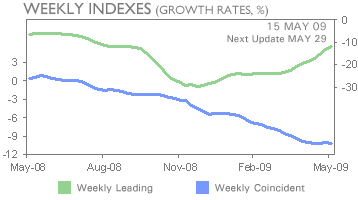
The WLI from ECRI is continuing to show improvement in economic conditions six months from now. In their statement last Friday, they said
With WLI growth rising steadily to a 35-week high, it is increasingly obvious that the 'green shoots' will blossom this summer.
The Conference Board, who is looked at the standard for future economic indicators, issued their April 2009 indicators – leading indicator (LEI) up 1%, coincident indicator (CEI) down 0.2%, and lagging indicator (down 0.5%). We all know how bad things are today so we focus on the leading indicator (LEI). This LEI index has risen for the first time in over a year which is indicating an economic turning point within a quarter or two.
This LEI is made up of several components as shown in the table below. You will note that stock prices account for almost half of the reason this index has improved. Although I agree with the conclusion of this index, I do not agree with the methodology.
Although not covered in this weekly economic wrap, I grow more and more concerned about the relative strength of the dollar. The dollar is currently under pressure mostly attributable to expectation of inflation.
Disclosures: long MMFs, PYEMX, EWZ, TIP, GLD, Physical Gold




